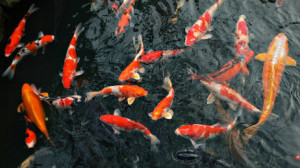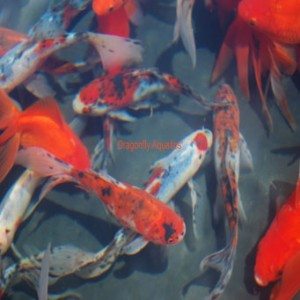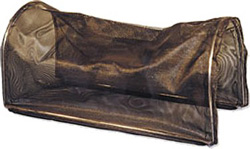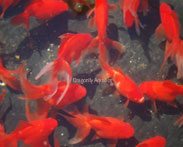With spring upon us its important to check on your fish. Its a critical time for them when they start coming out of dormancy. They are more likely to become vulnerable to illness unless proper steps are taken. When coming out of dormancy their bodies are low on the important nutrients needed to help ward of diseases.
First make sure you clean your pond out of all debris and sludge at the bottom. Microbe-Lift makes a good product called Sludge Away which can help. You can at this time replace about 30% of your pond water. If using tap water make sure you add a water conditioner to remove heavy metals, chlorine, and chloramines found in most tap water. If using tap water that goes through a softener this adds salt and its not necessary to add a water conditioner.
Its important to maintain a healthly ecosystem throughout the pond season. This will help maintain healthly fish and keep your pond clear and free of algae. Add a good beneficial bacteria, such as Microbe-Lift PL to your pond water regularly. Its amazing how this can help you keep your pond balanced.
 This is the best all around product to keep blue herons, king fishers and other persistent fish eaters away from your pond. The Scarecrow senses both heat and movement, then releases a noisy, three second burst of oscillating water. This is a harmless method of keeping fish eating wildlife away from your pond. Uses only two cups of water, with each burst. Hooks up to your garden hose and sensitivity of sensor can be adjusted for readings up to 35 feet away. Batteries are not included.
This is the best all around product to keep blue herons, king fishers and other persistent fish eaters away from your pond. The Scarecrow senses both heat and movement, then releases a noisy, three second burst of oscillating water. This is a harmless method of keeping fish eating wildlife away from your pond. Uses only two cups of water, with each burst. Hooks up to your garden hose and sensitivity of sensor can be adjusted for readings up to 35 feet away. Batteries are not included.
 Our first shipment of fish from Israel has arrived. Their flight was delayed a bit, so there were some casualties. I always feel bad for the ones that don't make it. Fortunately, most of them did survive the trip, and are adjusting to their new environments. Pretty close quarters in our holding tanks. Although, we have super filtration and UV sterilizers and watch them carefully for any signs of stress. Check out our website for fish availability, they will be ready to ship to your pond, next week. I expect this first shipment to go fast, so place your orders soon!
Our first shipment of fish from Israel has arrived. Their flight was delayed a bit, so there were some casualties. I always feel bad for the ones that don't make it. Fortunately, most of them did survive the trip, and are adjusting to their new environments. Pretty close quarters in our holding tanks. Although, we have super filtration and UV sterilizers and watch them carefully for any signs of stress. Check out our website for fish availability, they will be ready to ship to your pond, next week. I expect this first shipment to go fast, so place your orders soon!
 We have been taking advantage of the warm days we have been experiencing, getting the fish holding tanks clean, disinfected and ready for the first spring shipment of fish in a couple of weeks. As soon as they arrive, I will post what we will have available. Expecting, premium koi, butterfly koi, fantails, yellow comets, sarasa comets and shubunkins. We expect our first shipment April 11th from Israel. We then hold fish for a week before we will begin shipping them to our customers. This gives them a chance to recuperate from their long flight. Our fish are of the highest quality, guaranteed to be healthy upon arrival to your pond.
We have been taking advantage of the warm days we have been experiencing, getting the fish holding tanks clean, disinfected and ready for the first spring shipment of fish in a couple of weeks. As soon as they arrive, I will post what we will have available. Expecting, premium koi, butterfly koi, fantails, yellow comets, sarasa comets and shubunkins. We expect our first shipment April 11th from Israel. We then hold fish for a week before we will begin shipping them to our customers. This gives them a chance to recuperate from their long flight. Our fish are of the highest quality, guaranteed to be healthy upon arrival to your pond.
 Often times giving your koi a place to hide will keep them safe from predators. If building rock caves at the bottom of your pond is not feasible, then adding a Koi Kastle is a simple alternative. The Koi Kastle is made of aluminum framing with fiberglass mesh netting. It will provide a safe place for your fish friends and they will have fun swimming through it also!
Often times giving your koi a place to hide will keep them safe from predators. If building rock caves at the bottom of your pond is not feasible, then adding a Koi Kastle is a simple alternative. The Koi Kastle is made of aluminum framing with fiberglass mesh netting. It will provide a safe place for your fish friends and they will have fun swimming through it also!
 Reduce your fish feeding as the water temperatures drop below 60 degrees. Start feeding your fish a couple of times a week. We recommend switching to a wheat germ based fish food formulated for fall and spring feeding. When water temperatures drop below 60 degrees, the metabolism of your fish slows down. Both Tetra-Pond Spring/Fall and Microbe-Lift Cold Weather fish food are highly digestible cool weather diets that are made with less protein, but contain wheat germ, which is easily digested. They also contain higher levels of fat, which help your fish survive their winter hibernation. When water temperatures reach 50 degrees, stop feeding your fish completely. Feeding at water temperatures below 50 degrees can possibly kill your fish. A pond thermometer is a must have.
Reduce your fish feeding as the water temperatures drop below 60 degrees. Start feeding your fish a couple of times a week. We recommend switching to a wheat germ based fish food formulated for fall and spring feeding. When water temperatures drop below 60 degrees, the metabolism of your fish slows down. Both Tetra-Pond Spring/Fall and Microbe-Lift Cold Weather fish food are highly digestible cool weather diets that are made with less protein, but contain wheat germ, which is easily digested. They also contain higher levels of fat, which help your fish survive their winter hibernation. When water temperatures reach 50 degrees, stop feeding your fish completely. Feeding at water temperatures below 50 degrees can possibly kill your fish. A pond thermometer is a must have.
 We often get questions regarding stocking fish in ponds and thought we would give a general calculation of how many fish one can have in their water garden.
We often get questions regarding stocking fish in ponds and thought we would give a general calculation of how many fish one can have in their water garden.
You would first figure the total surface area of the water garden. Multiple length by width to find the area surface coverage. This will give you an idea as to how much oxygen will be available to them. If the surface of your pond has some coverage of floating plants you would include this area but don't include areas that contain marginal plants. Each inch of the fish should have 6 square inches to 1 square foot of water. Koi, however, need more space, and should have at least 25 square feet for every fish. You want to always go on the side of too much space rather than too little. You can use the following table to help you stock your pond.
1-2 inch fish - 1 square ft. 3-4 inch - 2 square ft. 5-6 inch - 3 square ft. 7-8 inch - 4 square ft. and so forth.
If you have aeration in the form of a waterfall or fountain, you can add a few more fish. A waterfall will actually aerate the water substantially and you could double the number of fish. Where as a water fountain doesn't provide as much aeration.
Fish, Comets,Calicos,Shubunkins,Koi, Sarasas, Yellow Comets here.
 It is only natural to put fish in your pond for the enjoyment of watching them but the way we feed them depends on the weather. During the cold winter months fish live off their stored body fat and will go into a rest period. What you feed your fish is dependent on your water temperatures. Give them high protein food during the warm months and high carbohydrate foods during the early spring and autumn. You may want to purchase a pond thermometer to monitor the temperature and place it 10-12 inches below the surface of your water.
It is only natural to put fish in your pond for the enjoyment of watching them but the way we feed them depends on the weather. During the cold winter months fish live off their stored body fat and will go into a rest period. What you feed your fish is dependent on your water temperatures. Give them high protein food during the warm months and high carbohydrate foods during the early spring and autumn. You may want to purchase a pond thermometer to monitor the temperature and place it 10-12 inches below the surface of your water.
As winter passes and spring arrives with water temperatures being below the 50s, the fish have been experiencing a form of hibernation. Their metabolisms are too slow during the cold period to be able to digest food so you don't want to feed them. Their activity is minimal as they survive the winter months by burning the stored body fat they accumulated prior to winter.
On the few warmer days of spring they will come to the surface acting as though they want fed. The water should be stabilized around 50 degrees before you resume feeding your finned pets. You will want to feed them easily digestible food, such as a wheat-germ-based floating pellet to start with since their digestive systems are still slow. Microbe-Lift makes a Fall/Spring Fish food that is wheat germ and easily digested. Feed the fish in the morning, feeding them lightly at first so that they will digest their food before the temperature lowers at night for a couple weeks. Once the water temperatures rise above 55 degrees resume feeding them their normal high-protein food.
Once autumn starts approaching and the water temperatures begin to cool, switch back to the wheat-germ-based food. Begin to taper off the amount of food as the appetite of your fish starts to decrease.
A good rule of thumb is to only feed your fish what they can consume in a 5 to 10 minute period. You can then net out any left over food so that is doesn't sink and rot in your pond causing more sludge. When your water temperature falls to below 50 degrees you want to stop feeding them completely.
You may want to add some flake food or balls of cooked oatmeal to your feeding regiment for the baby fish once they start to appear in early spring.
Adding fish to your pond can be a rewarding experience and you'll have yet another thing to enjoy while relaxing by your pond.
Buy pond thermometer and pond fish here.